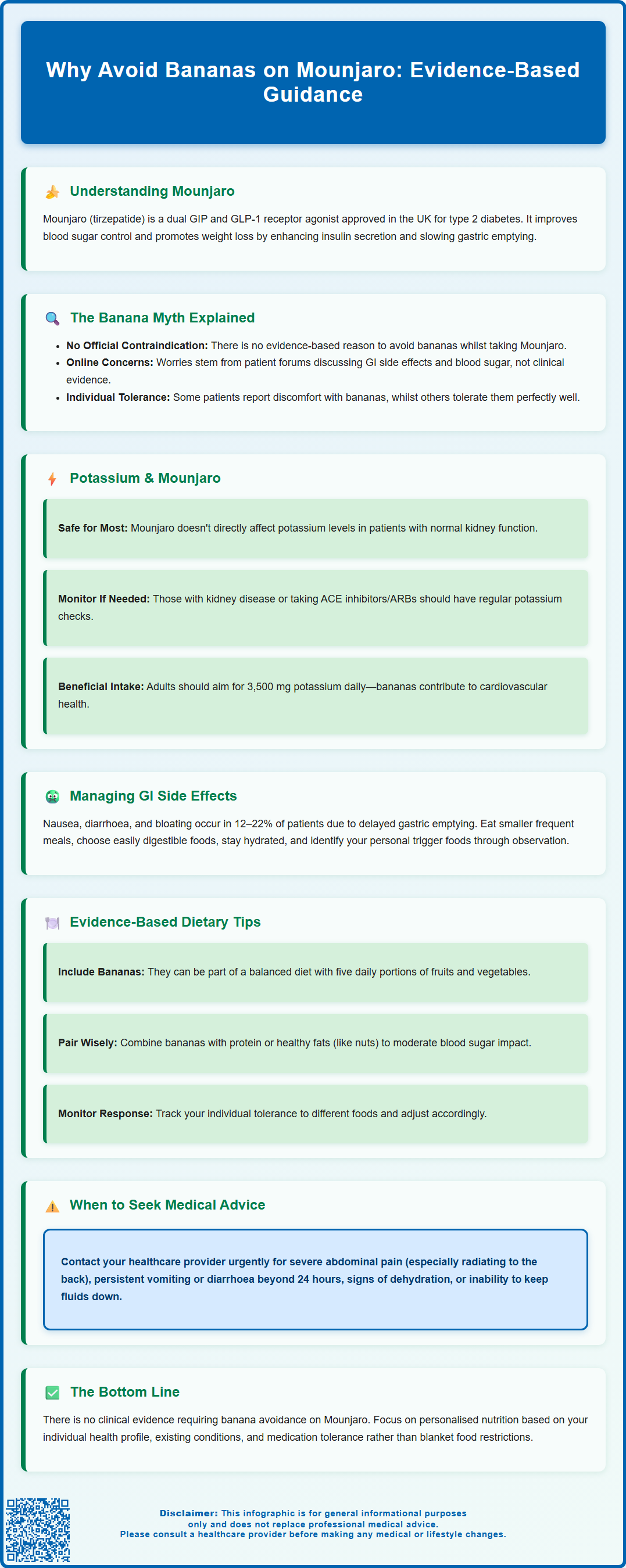Wegovy®
A weekly GLP-1 treatment proven to reduce hunger and support meaningful, long-term fat loss.
- ~16.9% average body weight loss
- Boosts metabolic & cardiovascular health
- Proven, long-established safety profile
- Weekly injection, easy to use

Mounjaro (tirzepatide) is a dual GIP and GLP-1 receptor agonist licensed in the UK for type 2 diabetes management. Whilst online discussions often suggest avoiding bananas during treatment, there is no clinical evidence or official guidance supporting this restriction. The Mounjaro Summary of Product Characteristics does not list bananas or any specific fruits as contraindicated. Concerns typically relate to gastrointestinal tolerability, blood glucose management, and potassium content. Understanding the pharmacology of tirzepatide and how individual dietary choices may affect treatment side effects enables patients to make informed decisions. This article examines the evidence behind banana consumption whilst taking Mounjaro and provides practical, evidence-based dietary guidance.
Summary: There is no clinical evidence or official UK guidance requiring patients to avoid bananas whilst taking Mounjaro (tirzepatide).
Mounjaro (tirzepatide) is a dual glucose-dependent insulinotropic polypeptide (GIP) and glucagon-like peptide-1 (GLP-1) receptor agonist for which the Medicines and Healthcare products Regulatory Agency (MHRA) has granted a UK marketing authorisation for the treatment of type 2 diabetes mellitus. Clinical trials have demonstrated significant improvements in glycaemic control and weight reduction. Tirzepatide works by enhancing insulin secretion in a glucose-dependent manner, suppressing glucagon release, and slowing gastric emptying, which collectively improve blood glucose management and promote satiety.
Administered as a once-weekly injection with gradual dose escalation, Mounjaro is designed to minimise side effects while optimising treatment outcomes. Patients prescribed Mounjaro often receive guidance about dietary modifications to manage potential gastrointestinal effects and support treatment goals. Importantly, there is no official contraindication to consuming bananas or any specific fruit whilst taking tirzepatide, as confirmed in the Mounjaro Summary of Product Characteristics (SmPC).
Concerns about certain foods, including bananas, have emerged in patient forums and online discussions. These typically centre around gastrointestinal tolerability, blood glucose management, and electrolyte balance—particularly potassium levels.
It is essential to distinguish between evidence-based clinical guidance and anecdotal advice circulating on social media platforms. Neither the prescribing information for Mounjaro nor NICE guidance on GLP-1 receptor agonists specify fruit restrictions. However, understanding the pharmacological effects of tirzepatide and how certain foods may interact with treatment side effects can help patients make informed dietary choices. Healthcare professionals should provide individualised nutritional counselling based on each patient's metabolic profile, comorbidities, and tolerance to the medication.

The suggestion to avoid bananas whilst taking Mounjaro appears to stem from several interconnected concerns rather than established clinical evidence. Bananas are nutrient-dense fruits containing approximately 12–15 grams of natural sugars (primarily fructose, glucose, and sucrose) per medium fruit, alongside dietary fibre, potassium, vitamin B6, and vitamin C. For individuals with type 2 diabetes, the glycaemic impact of any carbohydrate-containing food warrants consideration. Bananas have a moderate glycaemic index that varies with ripeness—generally lower when less ripe and higher when fully ripe.
Some patients report that consuming bananas or other higher-sugar fruits may exacerbate the gastrointestinal side effects commonly associated with GLP-1 receptor agonists, including nausea, bloating, and altered bowel habits. This is largely based on individual experiences rather than clinical studies. The mechanism behind this observation may relate to the delayed gastric emptying induced by tirzepatide. When the stomach empties more slowly, foods that are naturally higher in simple sugars or fermentable carbohydrates may remain in the digestive tract longer, potentially intensifying feelings of fullness, discomfort, or nausea in some individuals.
Additionally, the high potassium content of bananas (approximately 400–450 mg per medium fruit) has raised questions about electrolyte management in patients taking Mounjaro, particularly those concurrently prescribed medications affecting potassium homeostasis. However, it is important to emphasise that there is no documented pharmacological interaction between tirzepatide and dietary potassium that would necessitate banana avoidance in the general population taking this medication, as confirmed in the Mounjaro SmPC. Individual tolerance varies considerably, and what causes discomfort in one patient may be perfectly well-tolerated by another.
Potassium is an essential electrolyte crucial for cardiac function, muscle contraction, and nerve transmission. Normal serum potassium levels range from 3.5 to 5.0 mmol/L, and both hypokalaemia (low potassium) and hyperkalaemia (high potassium) can have serious clinical consequences. GLP-1 receptor agonists, including tirzepatide, do not directly alter potassium handling by the kidneys, nor do they have a recognised mechanism that would cause clinically significant changes in serum potassium levels in most patients.
However, certain clinical scenarios warrant monitoring of electrolytes in patients prescribed Mounjaro. Individuals experiencing significant gastrointestinal side effects—particularly persistent vomiting or diarrhoea—may develop electrolyte disturbances, including hypokalaemia due to gastrointestinal losses. Conversely, patients with chronic kidney disease (CKD) or those taking medications such as angiotensin-converting enzyme (ACE) inhibitors, angiotensin receptor blockers (ARBs), potassium-sparing diuretics, or non-steroidal anti-inflammatory drugs (NSAIDs) may be at increased risk of hyperkalaemia and should have their potassium levels monitored regularly. Patients with advanced CKD should seek personalised advice from their renal team or dietitian regarding potassium intake.
For the vast majority of patients taking Mounjaro with normal renal function and no concurrent medications affecting potassium balance, consuming potassium-rich foods like bananas poses no risk and may actually be beneficial as part of a balanced diet. The UK Government's Scientific Advisory Committee on Nutrition (SACN) recommends that adults consume approximately 3,500 mg of potassium daily, which supports cardiovascular health. Patients concerned about their potassium intake should discuss their individual circumstances with their GP or diabetes specialist nurse, who can arrange appropriate blood tests if clinically indicated. Blanket advice to avoid bananas is not supported by current evidence and may unnecessarily restrict a nutritious food choice.
Gastrointestinal adverse effects are among the most commonly reported side effects of Mounjaro and other GLP-1 receptor agonists. According to the Mounjaro SmPC, clinical trials demonstrated that nausea occurred in approximately 12–22% of patients (dose-dependent), with other frequent effects including diarrhoea, decreased appetite, vomiting, constipation, dyspepsia, and abdominal pain. These effects typically emerge during dose escalation and often diminish over time as the body adapts to the medication.
The mechanism underlying these gastrointestinal symptoms relates primarily to delayed gastric emptying—a therapeutic effect that contributes to improved glycaemic control and increased satiety but can also cause discomfort. When food remains in the stomach longer, patients may experience prolonged fullness, bloating, or nausea, particularly after consuming larger portions or foods that are high in fat, sugar, or fibre. Some patients find that certain foods exacerbate these symptoms, leading to individualised dietary modifications.
Regarding bananas specifically, some individuals report that the fruit's texture, natural sugar content, or fibre may contribute to feelings of heaviness or nausea when consumed whilst experiencing GLP-1-related gastrointestinal effects. However, others tolerate bananas well and find them a convenient, gentle option when appetite is reduced. Practical strategies to minimise gastrointestinal discomfort include: eating smaller, more frequent meals; choosing foods that are easier to digest; avoiding high-fat and heavily processed foods; staying well-hydrated; and eating slowly to allow the delayed gastric emptying process to occur naturally.
Patients should be advised to identify their own trigger foods through careful observation rather than eliminating entire food groups based on generalised advice. If gastrointestinal symptoms are severe, persistent, or interfere with adequate nutrition and hydration, patients should contact their healthcare provider. Dose adjustment, temporary treatment interruption, or additional symptomatic management may be appropriate in such cases.
Importantly, patients should seek urgent medical attention for severe, persistent abdominal pain (especially if radiating to the back), with or without vomiting, as this could indicate pancreatitis. Similarly, right upper abdominal pain with fever may suggest gallbladder disease—both are uncommon but serious potential complications. Patients taking Mounjaro alongside insulin or sulfonylureas should be aware of increased hypoglycaemia risk and may need dose adjustments of these medications.
Women taking oral contraceptives should use additional barrier contraception for 4 weeks after starting Mounjaro or after each dose increase, as tirzepatide can temporarily reduce oral contraceptive absorption.
Patients are encouraged to report any suspected side effects via the MHRA Yellow Card scheme (yellowcard.mhra.gov.uk).
NICE guidance (NG28) on the management of type 2 diabetes emphasises individualised dietary advice as a cornerstone of treatment, alongside pharmacological interventions. For patients prescribed GLP-1 receptor agonists like Mounjaro, nutritional counselling should focus on achieving sustainable dietary patterns that support glycaemic control, promote gradual weight loss if indicated, and ensure adequate nutrient intake whilst minimising treatment-related side effects.
There is no evidence-based rationale for categorically avoiding bananas or any other specific fruit whilst taking tirzepatide, and no such restrictions appear in the Mounjaro SmPC. A balanced diet rich in vegetables, fruits, whole grains, lean proteins, and healthy fats remains appropriate for most patients with type 2 diabetes. Bananas can be incorporated as part of the recommended five portions of fruit and vegetables daily, with consideration given to portion size and overall carbohydrate distribution throughout the day. Pairing a banana with a source of protein or healthy fat (such as a small handful of nuts) may help moderate its glycaemic impact and improve satiety.
Patients should be encouraged to:
Monitor their individual responses to different foods and adjust accordingly
Maintain adequate hydration, particularly if experiencing gastrointestinal side effects
Consume a variety of nutrient-dense foods to prevent nutritional deficiencies during weight loss
Avoid skipping meals, which may worsen nausea or lead to hypoglycaemia if taking other glucose-lowering medications
Seek referral to a registered dietitian for personalised nutritional assessment and guidance
When to seek medical advice: Patients should contact their GP or diabetes care team urgently if they experience severe, persistent abdominal pain (with or without vomiting), especially if radiating to the back (possible pancreatitis) or right-upper-quadrant pain with fever (possible gallbladder disease). They should also seek prompt advice for persistent vomiting or diarrhoea lasting more than 24 hours, signs of dehydration (excessive thirst, dark urine, dizziness), inability to keep fluids down, or difficulty maintaining adequate nutrition.
Patients using insulin or sulfonylureas alongside Mounjaro should monitor for hypoglycaemia and may need medication dose reviews. Regular monitoring of HbA1c, renal function, and electrolytes should be conducted according to local diabetes care protocols. Healthcare professionals should provide balanced, evidence-based information that empowers patients to make informed dietary choices without unnecessary food restrictions that could compromise nutritional adequacy or quality of life.
No, there is no clinical contraindication to consuming bananas whilst taking Mounjaro (tirzepatide). The Mounjaro Summary of Product Characteristics does not restrict banana consumption, and no UK guidance advises avoiding this fruit during treatment.
For most patients with normal renal function, the potassium content in bananas poses no risk whilst taking Mounjaro. Patients with chronic kidney disease or those on potassium-affecting medications should discuss individual dietary needs with their healthcare team.
Individual dietary modifications based on personal tolerance may help manage gastrointestinal side effects such as nausea or bloating. Eating smaller, frequent meals and identifying personal trigger foods through observation is more effective than blanket food restrictions.
The health-related content published on this site is based on credible scientific sources and is periodically reviewed to ensure accuracy and relevance. Although we aim to reflect the most current medical knowledge, the material is meant for general education and awareness only.
The information on this site is not a substitute for professional medical advice. For any health concerns, please speak with a qualified medical professional. By using this information, you acknowledge responsibility for any decisions made and understand we are not liable for any consequences that may result.
Lorem ipsum dolor sit amet, consectetur adipiscing elit, sed do eiusmod tempor incididunt ut labore et dolore magna aliqua. Ut enim ad minim veniam, quis nostrud exercitation ullamco laboris nisi ut aliquip ex ea commodo consequat. Duis aute irure dolor in reprehenderit in voluptate velit esse cillum dolore eu fugiat nulla pariatur.
Block quote
Ordered list
Unordered list
Bold text
Emphasis
Superscript
Subscript